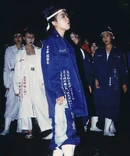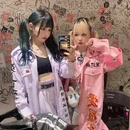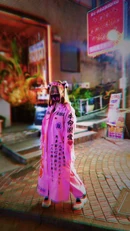| This page needs work. Please help us by expanding it. If you aren't sure how to help, check the article guide Format and Content Reason: Fashion section should explain the reason and meaning behind the various style traits of sukeban in more detail. |
Sukeban (スケバン) is a former Japanese subculture as well as the name of a fashion style derived from the looks of rebellious girl gangs. It first emerged during the 1960s as a form of rebellion against societal gender norms that expect women to always behave and dress well-mannered, causing a rise of deliquent girls enganging in anti-social and violent behaviour as a form of feminism.[1]
Older sukeban were often also members of bosozoku biker gangs.
History[]
The popularization of the word Sukeban is largely due to movies, TV shows, and manga in the 1970s and 1980s. There are multiple theories for the meaning of the term, but the most common is that it is a portmanteau of "Suke" (slang for girl in Japanese) and "Banchō" (boss of a delinquent gang) forming "Sukeban" which makes it roughly translate to "girl boss". The word "Sukeban" originated from Norifumi Suzuki's "女番長ブルース 牝蜂の逆襲" (On'na Banchō Series: Queen Bee Strikes Again), which had "スケバン" (Sukeban) written underneath the On'na Banchō part (as Ruby characters, a way to give an alternate reading of words in Japanese).
Fashion[]
As most members of girl gangs are still school age, they still have to wear school uniforms most of the time which are modified to show off their signature styles: blouses are cropped to expose the bare waist, skirt length is increased, and loafers are replaced by sneakers. Another key feature is the long customized coats (特攻服) which feature feminist symbology and anarchic messages in kanji.
Media[]
Television[]
Sukeban TV shows were popular during the 1980s. They almost always featured the sterotypical depiction of a sukeban character wearing a blue sailor suit with a long skirt. They featured action and fighting and were usually based around the sukeban characters having powerful abilities or tools.
- Sukeban Deka (based on the manga of the same name)
- Shoujo Commando Izumi
Manga & Anime[]
A notable example of sukeban in fiction is Saki Nikaido from Zombieland Saga. She was a biker gang leader who originates from the 90s, and both her normal outfit and her first performance outfit are examples of the sukeban style.
The character of Sailor Jupiter from the Sailor Moon franchise was originally written as being a part of this subculture, but it was quickly dropped, though she does retain some elements, especially in her hairstyle and school uniform.
Video Games[]
Shenmue takes place in the town of Yokasuka, Japan and features a sukeban gang with characters, including the leader Yumiko Minamino. The sukeban wear schoolgirl outfits with skirts modified to be very long and colorful eye makeup. Their activites include squatting in alleyways, hanging out with the Yankis, using rods and razor blades as weapons, insulting the player's character, and recruiting girls to their gang.
Resources[]
External links to help get a better understanding of this aesthetic.



